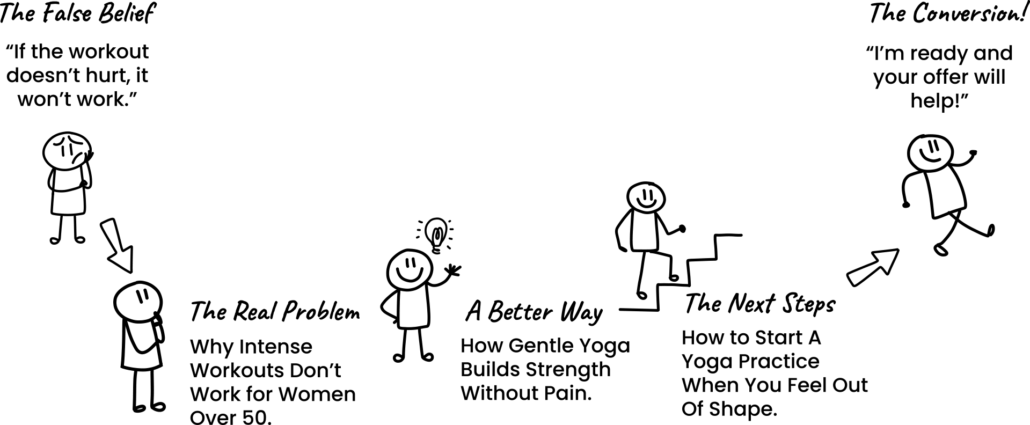If you’re reading this, I know that you want your blog to do more than just exist, you want it to lead people to your offers. And you also know (or at least suspect) that the old “keyword-first” SEO tactics don’t work the way they used to.
In this post, I’m going to show you how to take a more effective SEO tactic — creating topic clusters and pillar posts — and modernize it so it makes even more sense for your business, your potential customers, AI search, and Google too.
Key Takeaways: The New Business Blogger’s Playbook
Your Goal Has Shifted: Stop chasing random keyword traffic. The goal of your content should be to shift audience beliefs and prepare them for your offers.
The Conversion Cluster Difference: This is content organized in a way that guides your audience to a sale. Your Conversion Cluster acts as the roadmap they need.
“The Organic Traffic Machine” Rewards Coherence: Google and AI reward content that’s organized and shows deep expertise across an entire topic.
Keywords are a Validation Tool: Write for your buyer, then use keyword research to ensure you’re speaking their language. The keywords follow the strategy, not the other way around.
- It’s Time To Forget About Keywords And Start Thinking About Topic Systems
- A New Way to Think About Pillar Posts & Topic Clusters
- Conversion Clusters: Content Structured to Shift Beliefs
- How A Conversion Cluster Works (Example)
- The Conversion Cluster Formula (Give It A Try!)
- Here’s What Changes When You Build A Conversion Cluster:
It’s Time To Forget About Keywords And Start Thinking About Topic Systems
For years, the blogging playbook was simple: find keywords with search volume, write posts targeting those keywords, hope for traffic, hope harder that traffic converts.
The problem? It took forever to rank for anything meaningful. And now that zero-click searches are eating most of the clicks anyway (thanks, Google), that entire strategy just… doesn’t make sense at all anymore.
Here’s what’s liberating about this moment:
You don’t need Google’s permission to decide what to write about anymore.
You can create the content your audience actually needs before they buy from you. Content that prioritizes your business goals. Content that makes sense.
If you write good content that guides your audience through what they need to understand before buying, you’ll hit the right keywords naturally. And if you connect these topics together through interlinking, you’ll create the kind of content ecosystem that ranks and gets cited by AI.
This is where pillar posts and topic clusters come in.
The strategy:
Write content that meets your potential customers where they are and moves them toward your offer. Use topic clusters, pillars, and interlinking to show your expertise (a.k.a. “topical authority”).
Keywords become:
“Am I using the right language?” They’re a validation tool, not a starting point. That’s the shift.
A New Way to Think About Pillar Posts & Topic Clusters
Most people learn about pillar posts through old-school SEO, where a pillar post is defined as an “ultimate guide” or “authority page.” In practice, that usually means the longest post you’ll ever write, a giant SEO hub stuffed with links, or an info-dump of everything you know.
A topic cluster includes “related posts” that link to and from the pillar.
See: Why Topic Clusters Make Your Blog Content 10x More Powerful
This approach is already an improvement from the outdated “find keywords and write content based on those keywords” approach. But business owners don’t actually want traffic, they want the result of traffic: buyers. So we can do better.
Back to basics: How do you get buyers?
You shift beliefs.
People don’t buy when you give them more tips. They buy when they believe:
- Their current approach won’t work
- A new approach would work
- They can see themselves succeeding with that approach
- You are the right guide for that approach
The role of your content is to shift those beliefs—which is very hard to do if you’re chasing random keywords.
Conversion Clusters: Content Structured to Shift Beliefs
I’m using the phrase “conversion clusters” instead of just regular-old “topic clusters” because I needed a way to explain the difference. Conversions are the intent, not just traffic.
Old way: Find a bunch of related keywords to write blog posts about and then create a pillar post to link them all together.
New way: Start with the belief that’s holding your audience back, write posts that help them understand a better way, and use a Conversion Pillar to tie everything together.
❌ NOT: “Buy my stuff!” in every single blog post.
✅ Intentionally creating content that meets people where they are and always, always provides them a path forward.
Let me show you what this looks like in practice…
How A Conversion Cluster Works (Example)
Let’s say you’re a yoga instructor selling an online group program for women over 50.
The Transformation: Women 50+ gain strength, mobility, confidence, and consistency through gentle, community-based yoga.
The False Belief Holding Them Back: “If the workout doesn’t hurt, it won’t work.”
Here’s how a conversion cluster shifts their beliefs one post at at time:

Then, A Conversion Pillar Post Simply Ties It All Together:
Example: Start Yoga at Any Age: A Confidence-Building Approach for Women Who Want Strength, Ease, and Community
This gives readers an overview of the entire journey, links out to all your cluster posts, and leads directly to your offer.
Belief shift → “I see the whole path now—I’m ready.”
Readers can enter from anywhere and navigate forward or backward through the journey.
The Conversion Cluster Formula (Give It A Try!)
Now that you’ve seen what it looks like, here’s the framework you can use for any offer:
Start With Your Offer’s Transformation
What’s the end result your customer gets?
Then, Identify a False Belief
This is the belief someone must release before they are ready to buy your offer. Choose one to start—ideally, the biggest/most common one.
Common false beliefs:
- “I need to be more ready / more advanced before I start.”
- “The old way will eventually work if I try harder.”
- “This only works for other people, not me.”
- “I don’t have enough time / knowledge / experience.”
Plan Out These 5 Cluster Posts:
- Post 1: Reveal the real problem (it’s not what they currently believe)
- Posts 2–3: Show them a better way
- Posts 4–5: Help them get started
PLUS one Conversion Pillar that ties it all together.
That’s 6 posts total. That’s doable.
Once you’ve built one Conversion Cluster, you have three possible next steps.
Option 1: Expand This Cluster
Use this when you want more traffic or depth around the belief shift you just built.
Add supporting posts such as:
- Common questions
- Myths + mistakes
- Beginner guides
- Stories or case studies
- List-style roundups
Supporting posts build reach and bring more people into the cluster so your core belief-shifting posts can do their job. Perfect for steady growth and strengthening your authority around one topic.
Option 2: Create Another Conversion Cluster for the Same Offer
Use this when you want to warm your audience from multiple angles for the same product or service.
Each new cluster:
- Shifts a different false belief
- Teaches a different part of your approach
- Ends with its own Conversion Pillar
- Still leads to the same offer
Option 3: Build a Conversion Cluster for a Different Offer
If you have multiple offers, you can simply repeat the process for whichever offer you want to focus on next.
The structure doesn’t change:
- Real Problem
- Better Way (x2)
- Next Steps (x2)
- Conversion Pillar
Here’s What Changes When You Build A Conversion Cluster:
Rather than a collection of related posts linked together so Google gives you love, you’re creating a roadmap that shifts beliefs and prepares buyers.
✅ It anchors your message. Instead of reinventing your angle every week, all posts now support one core belief shift. Your blog stops being a collection of tips and starts being a coherent teaching arc.
✅ It organizes your content. Instead of 50 random topics, 12 ideas you’ll never write, and 7 drafted-but-abandoned blogs, you now have a clear structure that tells you exactly what to write, why you’re writing it, and how it moves readers along the journey.
✅ It connects your content directly to your offer. Readers naturally understand how your offer fits because your content was designed to prepare them for it.
✅ It builds topical authority. Both AI search systems and Google reward structured content and interconnected topic clusters. A conversion pillar gives them a “map” of your thinking — showing depth, coherence, and expertise on a specific topic. This is what gets you recognized as an authority and potentially cited and ranked.
See: AEO vs GEO: What Business Bloggers Need to Know About AI Search Optimization
Ready to Future-Proof Your Blog?
The days of keyword chasing and content chaos are over! If you want a system that works for your buyers and gets cited by AI, I’m putting the final touches on something to help. It’ll simplify your process, help you convert more readers into buyers with your content, and future-proof your blog so it’s citable by AI and Google-friendly, too.

